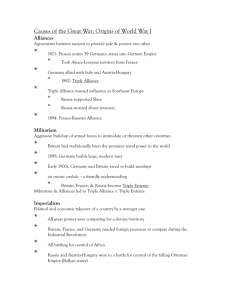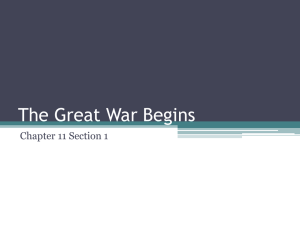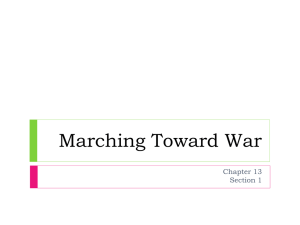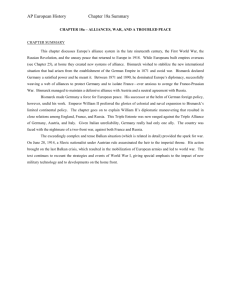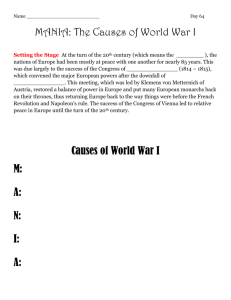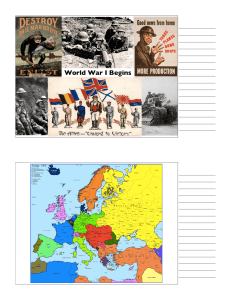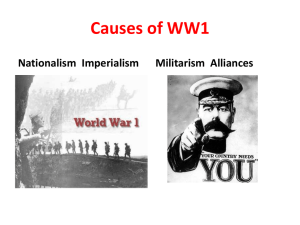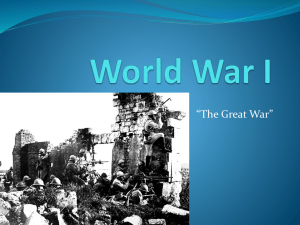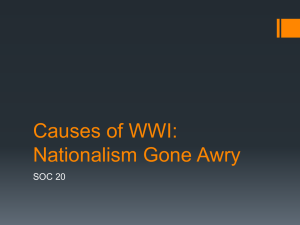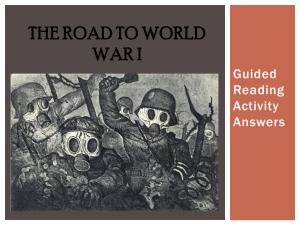2. The First world War: European Tensions Ignited
advertisement
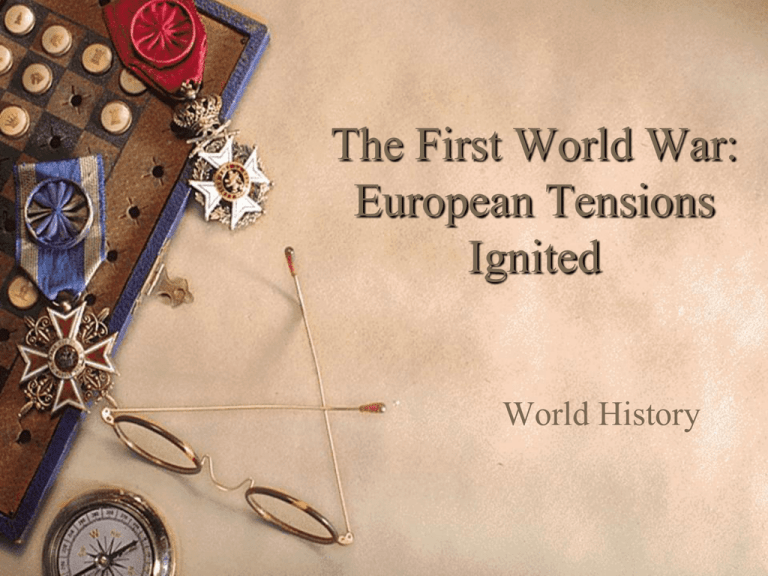
The First World War: European Tensions Ignited World History Causes of the War Consider the following questions and be prepared to discuss your answers. 1. What do you see here? 2. What do the different colors on the map represent? 3. Who is allied to whom? 4. Which countries might have the greatest or least need to join an alliance? 5. What are the advantages of joining alliances? Disadvantages? Europe at Its Peak In 1914, Western European countries were the most technologically advanced, wealthiest societies on earth. Europeans comprised 25% of the world’s population, the highest percentage of Europeans of any time in history Modernization created a feeling of superiority in Europe Militarism The policy of glorifying military power and keeping an army prepared for war. By 1914, all the great powers except Britain had large standing armies. Citizens feel patriotic Also frightened many. Kaiser Wilhelm II 1888 became ruler of Germany. Forced Bismarck to resign. Army was his greatest pride. Eager to show the world how mighty Germany had become. Tangled Alliances Growing rivalries and mutual mistrust had lead to the creation of several military alliances among the Great powers. Prussia’s chancellor, Otto von Bismarck, saw France as greatest threat to peace. Goal of Bismarck: to isolate France The System of Alliances Fearing the inevitable, countries began to form interlocking treaties, called alliances Two major alliances in Europe – Triple Alliance • Germany, Austria-Hungary, Italy – Triple Entente • Britain, France, Russia Triple Alliance Bismarck formed the Dual Alliance between Germany and Austria-Hungary. Three years later , Italy joined forming The Triple Alliance. Triple Entente Treaty between Britain, France, and Russia. Countries form alliance with each other- will not fight against each other. Imperialism Nations in Europe competed fiercely for colonies in Africa and Asia. This quest for colonies sometimes pushed Europeans to the brink of war. Sense of rivalry and mistrust among nations deepens. Nationalism Two forms of nationalism – A devotion to the interests of one’s nation • Feelings of national pride • Patriotism • Connected to imperialism and militarism – An aspiration for independence in a country under foreign domination • This form led to tensions in countries with large numbers of ethnic minorities (Why?) • Austria-Hungary had the most serious problem with this form War Breaks Out Consider the following questions and be prepared to discuss your answers. 1. What do you see here? 2. How are these people going to effect the OUT BREAK of WWI? MAKE A PREDICTION (HALF A PAGE) BE READY TO SHARE FOR DAPS!!! Ottoman Empire The Armenians suffered horrifically for its desire for independence from the Ottoman Empire. By 1880’s , roughly 2.5 million Armenians in the Ottoman Empire demanded their freedom. Throughout 1890’s, Turkish troops killed tens of thousands of Armenians. In 1914, Armenians pledged support to Turks’ enemies. Turks deported nearly 2 million. 600,000 die of starvation A Restless Region Early 1900s-Ottoman Empire, which included the Balkan region, was in rapid decline. New Nations: Bulgaria, Greece, Montenegro, Romania, and Serbia Nationalism a powerful force. Each group longed to extend its borders. Nationalism in the Balkans causes conflict Rivalry between Russia and Austria-Hungary developed over the Balkan Peninsula The area that formerly was controlled by the Ottoman Empire The Balkan Peninsula, “the powder keg of Europe”, contained many different ethnic groups that desired their independence Two “Balkan Wars”, 1912 and 1913, were fought helping keep tensions high Austria-Hungary and Serbia Austria-Hungary: Had a small Slavic population under its control Serbia: Had a large Slavic population, wanted to take in all Slavs in the Balkans, Start a Nationalism campaign Conflict: Austria-Hungary fears rebellion from its Slavic population Alliances in the Balkans Russia and Austria-Hungary both want control of the Balkans Russia, high Slavic population, sides with Serbia Austria-Hungary sides with Germany Russia is not militarily ready for war so they are forced to back down So what might make war break out now? Archduke Franz Ferdinand A Serbian nationalist terror organization, The Black Hand, planned to assassinate the heir to the throne and sent 7 assassins After avoiding 5 assassins, the archduke and his wife were assassinated by Gavrilo Principe Ultimatum On July 23 Austria-Hungary presented Serbia with an ultimatum which had to be answered in 48 hours Their demands – Stop all Anti-Austrian activity – Dismiss of all Serbian officials A-H objected to – The right to enter Serbia to investigate whether the Serbian government was involved Serbia agreed to the first two, but refused on the third Austria-Hungary declared war on Serbia on July 28th Alliances and Fronts of the War Consider the following questions and be prepared to discuss your answers. 1. What do you see here? 2. Who are the Allied Power? Central Powers? 3. Where are the western, eastern, Italian, and Balkan fronts of the war? 4. Which alliance seems to be winning? The Alliance System Leads to War Because of the alliance systems, Europe was at war within one week July 30th, Russia mobilized its armies moving troops towards Germany and A-H Germany, taking this as an act of war, issued two demands – Russia demobilize – France remain neutral Russia and France refused Germany declared war on Russia on August 1st and on France on August 3rd After Germany attacked neutral Belgium to get to France, Britain entered the war The Alliances World War I was fought between two sides, on primarily four European fronts The Triple Entente were called the Allies, and were joined by Belgium The Triple Alliance became known as the Central Powers – Italy refused to honor her alliance Eventually 31 nations joined the war
